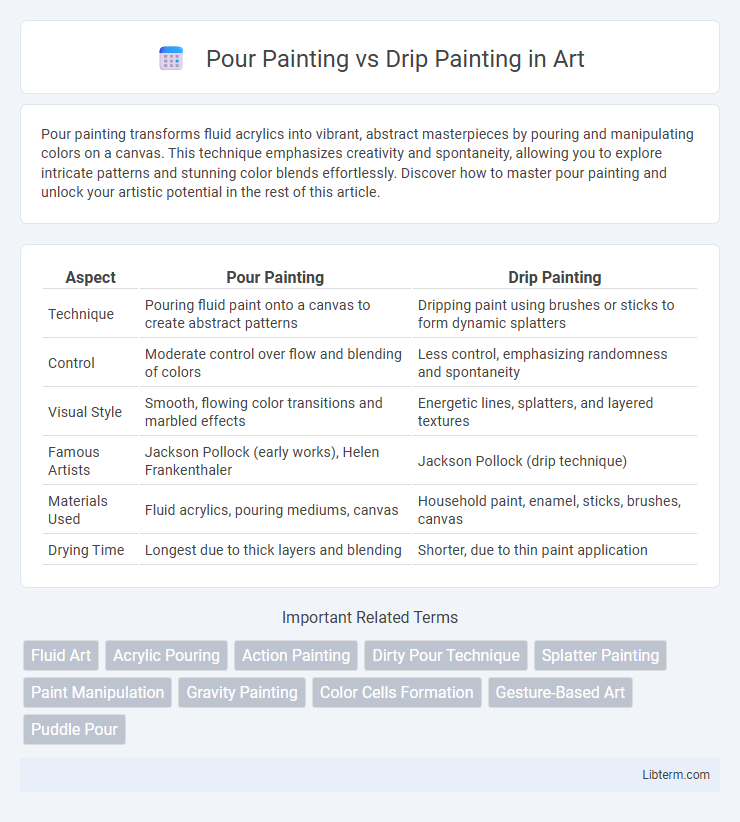Pour painting transforms fluid acrylics into vibrant, abstract masterpieces by pouring and manipulating colors on a canvas. This technique emphasizes creativity and spontaneity, allowing you to explore intricate patterns and stunning color blends effortlessly. Discover how to master pour painting and unlock your artistic potential in the rest of this article.
Table of Comparison
| Aspect | Pour Painting | Drip Painting |
|---|---|---|
| Technique | Pouring fluid paint onto a canvas to create abstract patterns | Dripping paint using brushes or sticks to form dynamic splatters |
| Control | Moderate control over flow and blending of colors | Less control, emphasizing randomness and spontaneity |
| Visual Style | Smooth, flowing color transitions and marbled effects | Energetic lines, splatters, and layered textures |
| Famous Artists | Jackson Pollock (early works), Helen Frankenthaler | Jackson Pollock (drip technique) |
| Materials Used | Fluid acrylics, pouring mediums, canvas | Household paint, enamel, sticks, brushes, canvas |
| Drying Time | Longest due to thick layers and blending | Shorter, due to thin paint application |
Introduction to Pour Painting and Drip Painting
Pour painting utilizes a fluid art technique where acrylic paints are mixed with a pouring medium and poured onto a canvas to create vibrant, swirling patterns that blend naturally. Drip painting, popularized by Jackson Pollock, involves dripping or splattering paint from a brush or stick onto a horizontal surface, producing dynamic, abstract compositions characterized by energetic lines and textures. Both methods emphasize spontaneity and the unpredictable interaction of paint but differ in application style and visual outcome.
Defining Pour Painting: Techniques and Tools
Pour painting involves fluid acrylics poured directly onto a canvas to create dynamic abstract patterns through controlled manipulation of paint consistency and movement. Key techniques include dirty pour, flip cup, and swipe methods, each offering unique visual effects by varying the layering and flow of colors. Essential tools consist of silicone oil for cell formation, heat guns to enhance texture, and quality fluid paints designed for optimal viscosity and pigment dispersion.
Understanding Drip Painting: Methods and Materials
Drip painting involves the controlled splattering of liquid paint onto a canvas using tools such as brushes, sticks, or directly from containers, creating dynamic, linear patterns and textures. Common materials include enamel, acrylic, or oil-based paints, often thinned to achieve fluidity and varied viscosity for distinct drip effects. This technique emphasizes spontaneity and movement, contrasting with pour painting's smooth, flowing pours that generate abstract pools of color.
Key Differences Between Pour and Drip Painting
Pour painting involves fluid acrylics being poured directly onto a canvas, allowing colors to blend organically and create smooth, marbled effects, while drip painting uses controlled drops or flicks of paint to form distinct patterns and textures. Pour painting emphasizes fluid movement and blending of hues, whereas drip painting highlights rhythmic application and marked contrasts with more defined paint marks. The choice between pour and drip painting techniques significantly impacts the artwork's visual dynamics, texture, and level of detail.
Artistic Effects and Visual Outcomes
Pour painting produces smooth, fluid gradients with rich color blending and organic patterns, emphasizing spontaneity and depth in the artwork. Drip painting creates dynamic, energetic textures characterized by distinct drops, splatters, and linear streaks, resulting in a more chaotic and expressive visual impact. Both techniques offer unique artistic effects: pour painting excels in seamless color transitions, while drip painting highlights motion and texture.
Types of Paints and Mediums Used
Pour painting predominantly utilizes fluid acrylic paints combined with pouring mediums like Floetrol or silicone oil to enhance flow and create cells, while drip painting often employs thicker acrylics or oil paints applied with brushes or sticks for controlled splatters and lines. The choice of medium in pour painting affects viscosity and surface tension, facilitating smooth blending and vibrant color interactions; in contrast, drip painting mediums focus on maintaining paint thickness and adhesion to the substrate. Understanding these differences in paints and mediums is crucial for achieving the distinctive textures and effects characteristic of each technique.
Surface Preparation and Canvas Choices
Surface preparation for pour painting typically involves sealing the canvas with a gesso or primer to prevent absorption and ensure smooth paint flow, whereas drip painting may require minimal preparation due to its spontaneous application style. Canvas choices for pour painting favor primed, flat surfaces that enhance paint movement and color blending, while drip painting often utilizes raw or lightly primed canvases to emphasize texture and layering effects. Proper surface preparation and canvas selection directly impact the fluid dynamics and final visual intensity of each technique.
Creative Control: Randomness vs Precision
Pour painting emphasizes randomness, allowing fluid paints to flow and blend unpredictably, creating organic, abstract patterns that emphasize spontaneity and natural movement. Drip painting offers greater creative control with precise gestures and intentional drips, enabling artists to compose detailed, deliberate designs and textures. This contrast highlights the balance between embracing chance in pour painting and executing calculated precision in drip painting.
Popular Artists and Iconic Works
Jackson Pollock is a seminal figure in drip painting, known for masterpieces like "No. 5, 1948," where he employed energetic, spontaneous drips and splatters of paint. Pour painting, closely associated with artists like Helen Frankenthaler and Morris Louis, features works such as Frankenthaler's "Mountains and Sea," which showcase fluid, poured layers of color creating translucent effects. Both techniques revolutionized Abstract Expressionism, emphasizing movement and color interaction through distinct application methods.
Choosing the Right Technique for Your Art Style
Pour painting offers fluid, organic patterns with smooth color transitions ideal for abstract expressionists seeking spontaneity and vibrant textures. Drip painting emphasizes controlled splatters and layering, perfect for artists who prefer dynamic movement and structured chaos inspired by action painting. Selecting the right technique depends on your desired level of control, texture complexity, and artistic intention within contemporary or experimental art styles.
Pour Painting Infographic

 libterm.com
libterm.com